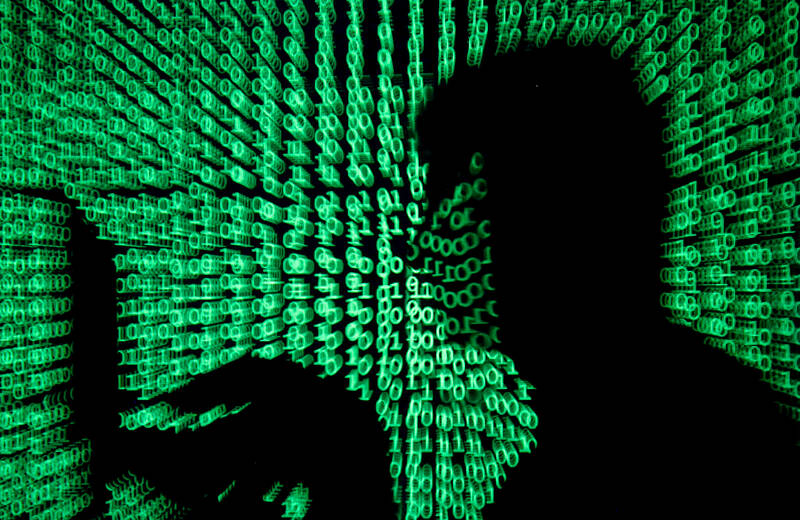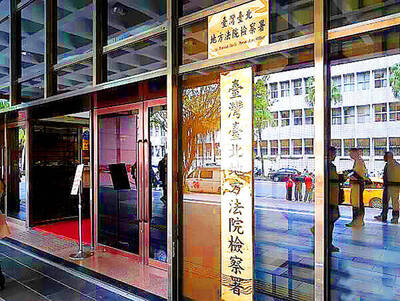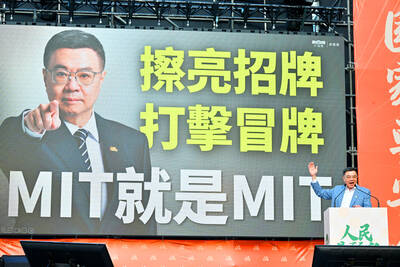China-affiliated cyberattacks against Taiwan jumped in the 24 hours before Taiwan’s presidential and legislative elections on Jan. 13, a report released on Tuesday by US cybersecurity firm Trellix found.
The report titled Cyberattack on Democracy: Escalating Cyber Threats Immediately Ahead of Taiwan’s 2024 Presidential Election said that malicious cyberactivity targeting Taiwan had jumped from 1,758 detections on Jan. 11 to more than 4,300 on Jan. 12.
The reason behind the activity and its success remains to be determined, the report said.

Photo: Reuters
Most of the attacks focused on internal communications in government offices, police department networks across Taiwan, and billing and insurance information from financial institutes, the report said.
The activity dropped noticeably to just more than 1,000 detections on election day, it said.
Trellix manager of intelligence analysis Anne An, who wrote the report, told Voice of America: “We see a lot of Chinese APTs [advanced persistent threat actors] that, after they get in, they stay low, maintain persistence... We don’t see this crazy spike.”
“The pattern of the attack is unusual,” she added.
An told Voice of America that Trellix is still looking into the issue, adding that a possible explanation was that Chinese threat actors were desperate to find any means possible to influence the elections at the last moment.
The Trellix report said that the surge in attacks the day before the elections are likely only part of China’s long-term strategy to threaten and attack Taiwan.
Separately, the European External Action Service (EEAS) on Jan. 23 released its 2nd EEAS Report on Foreign Information Manipulation and Interference Threats report indicating that China was behind a slew of disinformation campaigns to drive a wedge between the US and Taiwan.
EEAS spokesman Peter Stano on Tuesday last week said that one attempt to slander outgoing President Tsai Ing-wen (蔡英文) involved a 300-page electronic book published on X and other Web sites.
On April 6 last year, China’s state-run Global Times published illustrations insinuating that the US was using Tsai as a pawn, walking her toward a cliff, the report said, adding that the illustrations were later disseminated via social media.
Another article by state-run Chinese agencies falsely claimed that 30 Taiwanese political groups protested Tsai’s visit to the US, it said.
While the report said that it found very little use of artificial intelligence (AI) technology among the 750 incidents it reviewed, Taiwan AI Labs (台灣人工智慧實驗室) in January issued an analytic report saying that generative AI and large language models are being used heavily in disinformation campaigns.

INVESTIGATION: The case is the latest instance of a DPP figure being implicated in an espionage network accused of allegedly leaking information to Chinese intelligence Democratic Progressive Party (DPP) member Ho Jen-chieh (何仁傑) was detained and held incommunicado yesterday on suspicion of spying for China during his tenure as assistant to then-minister of foreign affairs Joseph Wu (吳釗燮). The Taipei District Prosecutors’ Office said Ho was implicated during its investigation into alleged spying activities by former Presidential Office consultant Wu Shang-yu (吳尚雨). Prosecutors said there is reason to believe Ho breached the National Security Act (國家安全法) by leaking classified Ministry of Foreign Affairs information to Chinese intelligence. Following interrogation, prosecutors petitioned the Taipei District Court to detain Ho, citing concerns over potential collusion or tampering of evidence. The

‘FORM OF PROTEST’: The German Institute Taipei said it was ‘shocked’ to see Nazi symbolism used in connection with political aims as it condemned the incident Sung Chien-liang (宋建樑), who led efforts to recall Democratic Progressive Party (DPP) Legislator Lee Kun-cheng (李坤城), was released on bail of NT$80,000 yesterday amid an outcry over a Nazi armband he wore to questioning the night before. Sung arrived at the New Taipei City District Prosecutors’ Office for questioning in a recall petition forgery case on Tuesday night wearing a red armband bearing a swastika, carrying a copy of Adolf Hitler’s Mein Kampf and giving a Nazi salute. Sung left the building at 1:15am without the armband and apparently covering the book with a coat. This is a serious international scandal and Chinese

Seventy percent of middle and elementary schools now conduct English classes entirely in English, the Ministry of Education said, as it encourages schools nationwide to adopt this practice Minister of Education (MOE) Cheng Ying-yao (鄭英耀) is scheduled to present a report on the government’s bilingual education policy to the Legislative Yuan’s Education and Culture Committee today. The report would outline strategies aimed at expanding access to education, reducing regional disparities and improving talent cultivation. Implementation of bilingual education policies has varied across local governments, occasionally drawing public criticism. For example, some schools have required teachers of non-English subjects to pass English proficiency

TRADE: The premier pledged safeguards on ‘Made in Taiwan’ labeling, anti-dumping measures and stricter export controls to strengthen its position in trade talks Products labeled “made in Taiwan” must be genuinely made in Taiwan, Premier Cho Jung-tai (卓榮泰) said yesterday, vowing to enforce strict safeguards against “origin laundering” and initiate anti-dumping investigations to prevent China dumping its products in Taiwan. Cho made the remarks in a discussion session with representatives from industries in Kaohsiung. In response to the US government’s recent announcement of “reciprocal” tariffs on its trading partners, President William Lai (賴清德) and Cho last week began a series of consultations with industry leaders nationwide to gather feedback and address concerns. Taiwanese and US officials held a videoconference on Friday evening to discuss the